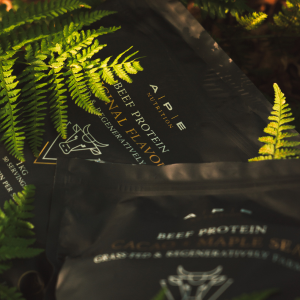Your Summer Nutrition
When it comes to Summer, there are some key aspects to focus on in order to protect and optimise health and wellbeing. To protect the skin from sun damage and improve vitamin D production, enjoy plenty of healthy fats from oily fish, fatty cuts of meat (ribeye), nuts and seeds such as chia and flax. Foods high in vitamins E and C can also protect the skin, as can lycopene (a carotenoid found in fruits and vegetables, but mainly tomatoes). Importantly, avoid processed seed oils such as rapeseed, sunflower, corn and soy oil, as these are highly inflammatory and can make the skin more susceptible to sun damage. In this article, we’ll dive deeper into how to optimise vitamin D levels from sunlight through nutrition too.
As sunlight intensity shifts throughout the year, our ability to metabolise carbohydrates also changes. In Autumn and Winter, the body moves to a more insulin-resistant state, meaning it can be more beneficial to focus on fats and proteins with less carbohydrates. In Spring and Summer, the body is often able to better metabolise carbohydrates and extract nutrition from a wider variety of foods, so this is a great time to enjoy seasonal fruits and raw honey. The theory of quantum nutrition also tells us that food is full of information from sunlight, soil, water and air. When we consume this food, and therefore this information, we’re giving the body signals about where we are in the world and how the body should function. So, eating locally grown berries and drinking raw milk from local cows helps align us with our environment to support our health here and now, whereas consuming pineapple grown in Costa Rica or gogi berries from China provides completely different ‘information’ and can therefore confuse the body on both physical and energetic levels.
So, in order to give your body the nutrients it needs to thrive this Summer in the UK, read on:

Vitamin C: Abundant in seasonal fruit and vegetables right now, consuming plenty of vitamin C can protect the skin from burning with its high antioxidant content. Consume vitamin C raw in order to preserve the antioxidant content. If things have been stressful for you recently, try bringing in plenty of vitamin C rich foods in order to replenish the adrenals, which tend to ‘use up’ vitamin C rapidly during stress.
Best sources: Blueberries, raspberries, cherries, broccoli, green beans
Vitamin E: Another powerful antioxidant, vitamin E can reduce free radicals and cell damage, whilst also naturally protecting the skin. Vitamin E is often found in skincare products, however consuming plenty of it can help nourish your skin from the inside-out, potentially improving your skin’s ability to absorb and generate vitamin D, as healthy skin has been shown to better utilise vitamin D from sunlight.
Best sources: Sunflower seeds, courgette, fish, chicken, cucumber
Vitamin A: Another nutrient vital for skin health, vitamin A is great example of how you can ‘eat your skincare’ to benefit your body from the inside-out this Summer. Again, many skincare products contain vitamin A in the form of retinol, however our ancestors would have obtained this essential nutrient from foods like liver to nourish skin and support optimal vitamin D absorption and utilisation.
Best sources: Beef liver, egg yolks, dairy
Zinc: A vital co-factor for vitamin D, zinc is essential for proper function and metabolism of vitamin D, especially when it comes from sunlight. Zinc especially plays a role in regulating the expression of vitamin D-dependent genes related to bone health, immunity, and metabolic processes. Zinc also supports cognitive function and reproductive health.
Best sources: Oysters, beef, eggs
Magnesium: Another co-factor for vitamin D, magnesium is involved in activating and converting vitamin D to its active form. This helps regulate calcium and phosphate levels, vital for bone health. Magnesium is also an electrolyte, which can be lost through sweating on hot Summer days. When we lose excess magnesium through sweating, this can lead to muscle soreness, cramping, fatigue and sleep disturbances, so look to increase your levels this season.
Best sources: Spinach, blackberries, figs
Sodium: Sodium is another crucial electrolyte that plays an important role in nerve and muscle function, brain health, digestion and overall wellbeing. Sodium regulates the amount of water in and around cells and contributes to blood pressure balance. We lose sodium through sweating, and some people lose more sodium than others depending upon genetics, sweat rate, diet, exercise intensity, and environmental conditions such as temperature. If you notice your clothes have white marks on them after a sweaty workout, or you often feel dizzy after exercise, these can be signs that you’re losing sodium and you may benefit from replenishing it with naturally sodium-rich foods or a pinch of sea salt in your water bottle.
Best sources: Sea salt, celery, seaweed
Potassium: Forming the third major electrolyte, potassium regulates muscle function, nerve function, and heart rhythm, and can also be lost through sweating. Having good levels of potassium also contributes to bone health, blood pressure balance and prevention of kidney stones, so it’s important to maintain healthy levels through warmer months.
Best sources: Potatoes, spinach, milk
Omega 3s: These important fats contribute to skin health, reduction of inflammation, brain health, mood and heart health. Omega 3s promote healthy skin, which as we mentioned is important in allowing the skin to generate good amounts of vitamin D from sunlight. The modern Western diet generally has an omega 6:3 ratio of 16:1, meaning many of us are consuming way more inflammatory omega 6 fats than anti-inflammatory omega 3s, potentially leading to inflammation and cardiovascular disease, so it can be very beneficial to try to balance your omega 3 and 6 intake.
Best Sources: Oily fish, flax seeds, oysters, spinach, seaweed, grass-fed beef, pasture raised eggs.
*Be aware that grass fed beef and pasture-raised eggs will both contain higher levels of beneficial omega 3s than grain-fed, so choose these when you can.
Lycopene: An antioxidant often found in red coloured foods, lycopene naturally protects the skin from sunburn throughout Summer. Lycopene has also been linked to cancer prevention by reducing the risk of normal healthy cells mutating into cancerous cells, particularly with regard to prostate cancer. Some studies also suggest lycopene can boost levels of procollagen in the skin, which is the precursor to collagen, and can help your grass-fed collagen give you even more benefit! Lycopene absorption is increased through the presence of fats, so try to consume your lycopene with those omega 3s or some local grass-fed butter.
Best Sources: Tomatoes (cooking tomatoes increases lycopene availability), apricots.
Hydrating foods: Not a specific nutrient in itself, but important to consider; hydrating foods are useful to focus on in Summer to help deeply hydrate the body on a cellular level. Water comes in many forms, and the form of water we consume from some foods is known as the ‘fourth phase’ of water. This ‘fourth phase’ is found in gel-like forms such as those found in cucumber and juicy fruits, and they help deliver essential minerals to the body for optimal hydration, whereas simply drinking lots of water can often simply flush minerals and electrolytes from the body.
Best sources: cucumber, leafy greens, milk, spinach, broccoli, strawberries, tomato.
Enjoy!
Written by Emma Newlyn
Emma is a health and nutrition coach who specialises in blending ancient wisdom and modern health techniques to help people feel well inside and out. Emma brings over 12 years of experience in the health industry to APE Nutrition, and specialises in answering your nutrition and supplement questions, and creating articles on many different areas of wellbeing.






